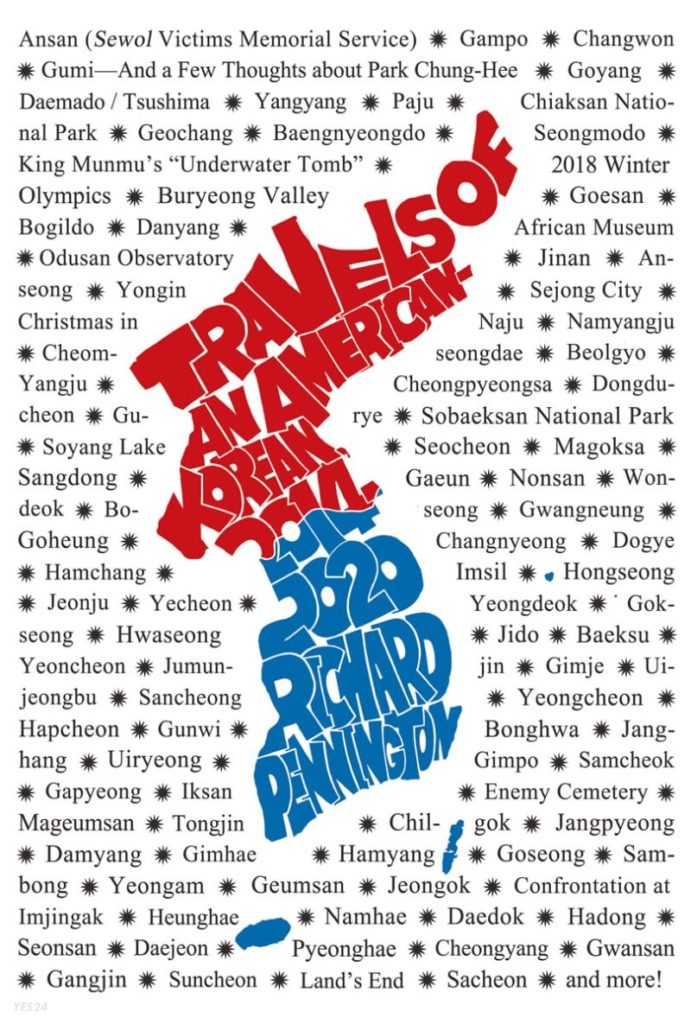Travels of an American-Korean 2014-2020
Reviewed by Michael Attard.
This book is a diary of Richard Pennington’s travels throughout South Korea between 2014 and 2020. The travels were prompted by his personal desire to deepen his understanding of Korea. The writings include memories and reflections, and his stated purpose is to educate and entertain his readers.
The 85 trips are in chronological order. In Chapter 1, he travels to Anseong in January of 2014, where he visited the Machum Museum. He explains that machum (맞춤) can have several meanings, but that in this case, it refers to well-made brassware. The brassware made in Anseong was produced for Korean nobility and sold to Japan, China, and even India and Arabia. Concise paragraphs relating lesser-known historical facts are found in almost every chapter.
One particular chapter I liked is “Confrontation at Imjingak.” In this entry, Pennington recounts how he was personally involved in a controversial social action. Close to the Demilitarized Zone, he was with a group of South Koreans who were attempting to send leaflets by hydrogen balloons into North Korea. I should clarify that he had been invited. The day, however, did not go as planned, as scuffles broke out and eggs were thrown. Apparently, it is the local people who are most against the floating of leaflets, as they feel that they have the most to lose. On this day, the locals won after the truck carrying the balloons was hijacked.

While many places in Korea have a historical connection to the distant past, Pennington has visited a multitude of sites pertaining to World War II and the Korean War. In October 2017, the author visited Namhae and the spot where an American B-24 was shot down on August 7, 1945, the day after an atomic bomb was dropped on Hiroshima. The story concerns a local Korean named Kim who found the crash site. The Japanese had gotten to the site first and took what they could use, leaving the eleven dead crew as they were. Kim, however, was compelled to give the Americans a proper burial. He knew this was dangerous and, sure enough, when the Japanese learned of what he had done, he was arrested and tortured. Fortunately for Kim, the war ended shortly thereafter, and he was freed. This is the type of story missing from most history books but found in this one.
On a lighter note, who has not had an Imsil Cheese Pizza since coming to Korea? Well, our author traveled to the town of Imsil in North Jeolla Province to learn the full story of how it was born. Apparently, a Belgian priest came to Korea in 1959 and somehow ended up in Imsil. The priest managed to get a pair of mountain goats and a cow or two. The problem was that he had no idea how to make cheese. That did not stop the father or the locals, and eventually they had a profitable cheese operation. And in keeping up with the times, there is even an Imsil Cheese Theme Park there today.
Our author has bounced all over Korea, and I wish that the book had a few maps. This would make the book more practical for those of us planning our own trips. Along the same lines, names in Hangeul would also help.
Everywhere he went, he met people, and it is clear that Pennington himself, not being shy, had a lot to do with this. On the other hand, his encounters reveal the friendliness and strong tendency of Koreans to offer help in any situation. So, without really saying so, his encounters serve as an encouragement to all of us to get out and explore. However, he gives us the names of almost everyone he meets, which slows down the reading.
As I said, all of the travels mentioned were in South Korea. But in the chapter “The PyeongChang Winter Olympics,” Mr. Pennington makes clear his feelings on the North Korean regime. He tells us that there was a concern that North Korea might do something to disrupt the games and reminds us that North Korea, just before the 1988 Seoul Olympics, had planted a bomb on a South Korean airliner, leading to the death of 115 people. He also tells us that no reference was made to the Olympics on North Korean television. No glimpse of life in South Korea was allowed.
This book is 441 pages, and the author gives us his opinion on other topics as diverse as the Catholic Church and Muhammad Ali. I realize that it is his diary, but hearing about his two-mile runs over and over, baseball games watched on television, and the book he was reading made the story tedious at times. I think his purpose would be better served and that he would attract more readers with a book half the size.
However, whether you are new to South Korea or have been here for a few years, Pennington’s book will definitely give you a look into the lesser-seen Korea.
The Reviewer
Michael Attard is a Canadian and has lived in Gwangju since 2004. Though officially retired, he still teaches a few private English classes. He enjoys reading all kinds of books and writes for fun. When the weather is nice, you may find him on a hiking trail.







